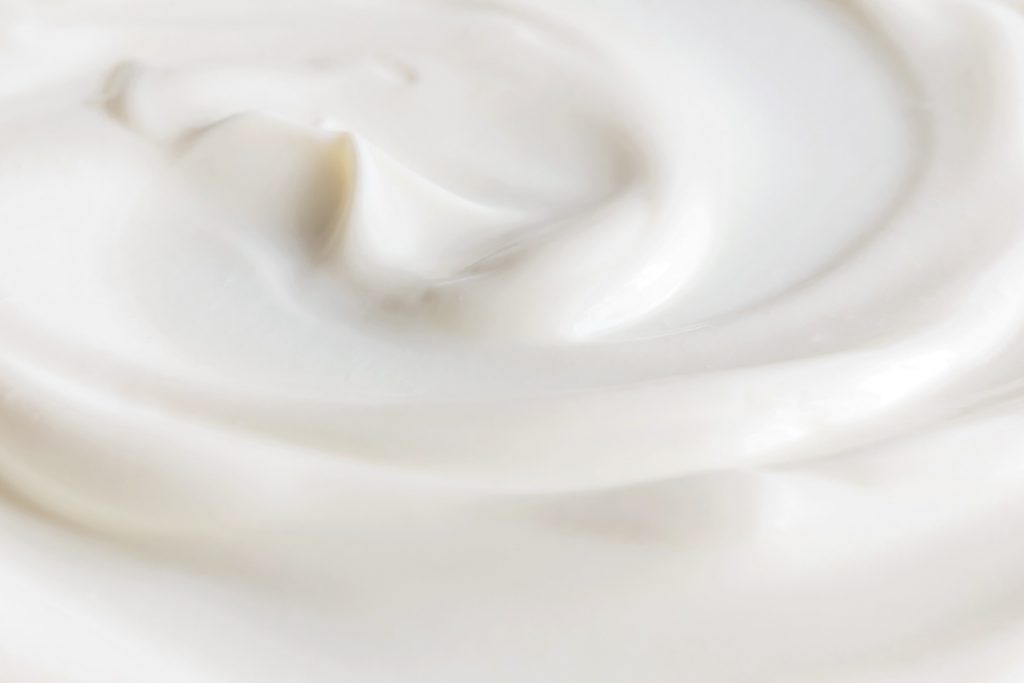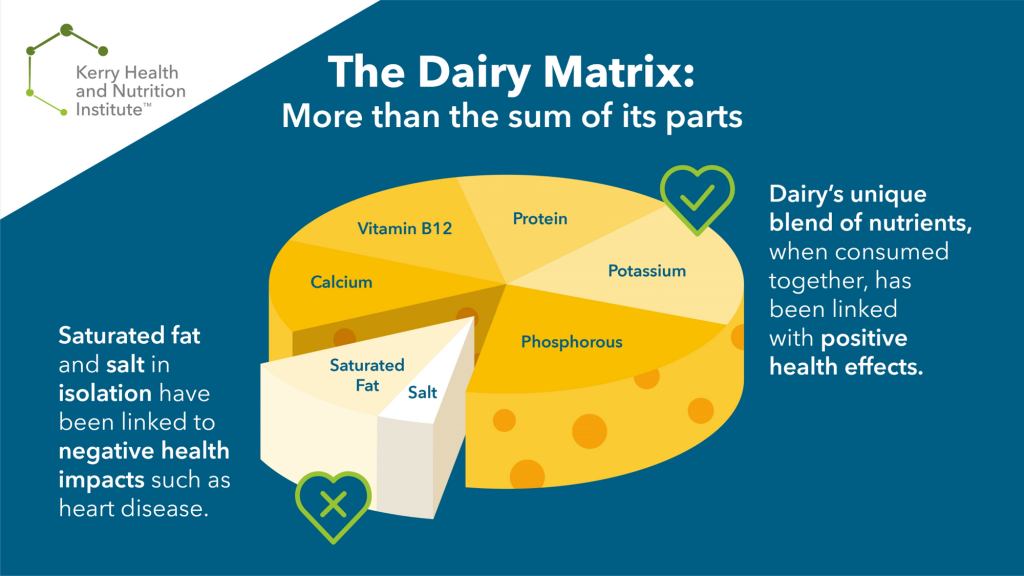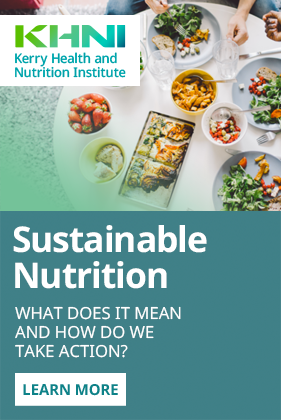Is dairy fat healthy or unhealthy?
Why do we see recommendations to reduce saturated fat intake, while at the same time see headlines from studies showing full-fat dairy may be healthy for us?
The answer lies in the fact that food can often be more than the sum of its parts.
Dairy, saturated fat & health
Dairy is a nutrient rich food group which has been championed for its role in bone, dental and muscle health for decades. On the contrary, dairy has also been the subject of ‘negative press’ concerning its saturated fat content, which is linked to heart disease and other metabolic complications. Cardiovascular disease (CVD) remains the number 1 cause of mortality globally, representing 31% of all deaths (1).
The effect of saturated fat on health has been hotly debated in recent years and the latest evidence review for Saturated Fat and Health from the UK Scientific Advisory Committee on Nutrition (August 1st, 2019) recommends limiting saturated fat intake to ~10% of total calories (2). Saturated fat raises blood cholesterol levels, particularly low-density lipoprotein (LDL) cholesterol, which is a primary risk factor for cardiovascular disease.
At the same time, recent evidence from several large prospective cohort studies, systematic reviews and meta-analyses combining the results of thousands of subjects, have shown that milk and dairy foods, which can be high in saturated fat, have neutral or protective effects on cardiometabolic diseases (3-6).

These studies are having an impact on people’s beliefs of dairy. The idea that dairy fat is healthy is becoming more widespread among consumers. Bulletproof coffee, which encourages adding dairy fat to coffee specifically for potential health benefits, has grown into a successful lifestyle brand, and full-fat dairy is often encouraged as part of the ketogenic diet, one of the most popular diets in the world.
Whole milk and yoghurt have a saturated fat content of 2.3%, however cheese can range from 3-35% saturated fat which means that dairy is often targeted by public health bodies in efforts to reduce saturated fat intake. However, recent evidence has shown that cheese consumption does not raise LDL cholesterol compared to the same amount of fat from butter (7). This paradox may be due to a theory known as the ‘Dairy Matrix’. In reality, we eat whole foods rather than single nutrients. Dietary recommendations to reduce saturated fat do not distinguish between nutritionally poor ‘fried processed foods’ and nutritionally dense foods such as dairy.
How can a food high in saturated fat be healthy?
The Dairy Matrix: more than the sum of its parts
Dairy is a unique blend of nutrients including calcium, phosphorus, iodine, Vitamin B2 and B12, fermented cultures (yoghurt and cheese) bioactive peptides and high-quality protein containing all of the essential amino acids. Recently, scientists are considering the effects of milk and dairy foods on health beyond the benefits of the individual nutrients they contain. ‘The Dairy Matrix’ hypothesis suggests that the nutrients in dairy can interact with one another in ways that are beneficial for health (8).
Studies show that the dairy matrix has health benefits beyond the individual supplementation of the same nutrients and effective on cardiometabolic disease, weight management, bone mass density, bone metabolism, blood lipid levels and blood pressure (9).
Is cheese good or bad for heart health?
In relation to cheese, the explanation for the beneficial rather than harmful effects on cardiovascular diseases (CVD) might be due to interactions between components of the cheese matrix, including calcium, phosphorus, the milkfat globule membrane, and starter cultures, which together modify saturated fatty acid-induced increases in blood lipids. One thought is that these nutrients may block absorption of the saturated fats in cheese, but this has not been proven.
A 2018 study published in the American Journal of Clinical Nutrition examined the effects of dairy fat in cheese versus butter on markers of cardiometabolic health in 164 overweight volunteers. They consumed 40g dairy fat daily for 6 weeks, one group consumed the fat as cheddar cheese and another group consumed the fat as butter (matched for calcium and protein). Results indicated that dairy fat, eaten in the form of cheese, appears to differently affect blood lipids compared with the same constituents eaten in a butter matrix, with significantly lower total cholesterol observed when all nutrients are consumed within a cheese matrix (10). Observational studies have also shown that yoghurt and cheese consumption are linked to a reduce risk of diabetes (6, 8).
Dairy and bone health: more than just calcium?
Furthermore, the effects of milk and dairy foods on bone health may be due in part to positive interactions of calcium, protein and phosphorus with each other and with lactose and bioactive peptides in the dairy matrices, rather than simply a ‘calcium effect’ as is often assumed (11). Similarly, milk is a key element of the Dietary Approaches to Stop Hypertension (DASH) diet for preventing and treating blood pressure. This anti-hypertensive property is likely due to the combination of minerals and protein found in dairy. Moreover, a study examining the effects of cows’ milk, calcium fortified soy milk and calcium supplement on weight and body fat reduction in premenopausal overweight and obese women found that weight loss was greatest in subjects consuming milk compared to calcium matched soy drink and calcium supplements (12).

Emerging research on the dairy matrix and health
- Bioactive peptides present in milk are being investigated in relation to cardiometabolic health, immune health and (13).
- Fermented dairy contains bacteria with potential to produce short chain fatty acids in the gut which can have positive health benefits (14).
- Dairy fat has >400 fatty acids with different physiological properties. Milk fat globule membrane (MFGM) encloses the fatty acids and has shown potential benefits in relation to lipid metabolism (15)
- Dairy fat contains odd chain fatty acids C15 and C17 which cannot be synthesised by the body and are used as biomarkers of dairy intake. These fatty acids are contained in MFGM and may confer health benefits such as reduced risk of CVD and Type 2 Diabetes (16-17)
- Grass fed dairy products have higher levels of polyunsaturated fat Conjugated Linoleic acid which has shown potential benefits for cardiometabolic health. See link to our article about the Nutrition Benefits of Grass fed dairy.
- Food is complex in terms of its nutritional content and physical structure which can impact the digestion and metabolism of the nutrients. The structure of dairy products varies from the solid matrix of cheese, to the gel-like structure of yogurt, to liquid milk. Rates of gastric emptying can affect satiety and appetite.
- The matrix structure can also influence protein absorption. Casein consumed in a milk matrix is more slowly digested and absorbed than in supplement format, without an impact on muscle protein synthesis (18).
More research into the dairy matrix will allow us to fully understand the health benefits of dairy but current evidence indicates that dairy is a nutritious food group that contributes positively to overall health when eaten as part of a balanced diet.
In recent years, many people are choosing to reduce /remove dairy from their diet due to a variety of reasons such as veganism, taste preferences, intolerance, to promote animal welfare and environmental sustainability. However, removing dairy from the diet should be carefully considered as it is a major source of nutrients and significant efforts should be made to ensure the diet is nutritionally balanced. A registered Dietitian or Nutritionist can support with individualised advice for meeting dietary requirements.
-
References
- World Health Organisation. Cardiovascular Disease Factsheet 2017. https://www.who.int/en/news-room/fact-sheets/detail/cardiovascular-diseases-(cvds)
- Saturated Fats and Health. SACN report 2019. https://www.gov.uk/government/publications/saturated-fats-and-health-sacn-report
- Elwood PC, Pickering JE, Givens DI, Gallacher JE. The consumption of milk and dairy foods and the incidence of vascular disease and diabetes: an overview of the evidence. Lipids. 2010;45:925–39
- Soedamah-Muthu et al (2011) Milk and dairy consumption and incidence of cardiovascular diseases and all-cause mortality: dose-response meta-analysis of prospective cohort studies. Am J Clin Nutr 93, 158-171.
- Soedamah-Muthu et al (2012) Dairy consumption and incidence of hypertension: A dose-response meta-analysis of prospective cohort studies. Hypertension 60, 1131-1137.
- Chen et al (2014) Dairy consumption and risk of Type 2 Diabetes: 3 cohorts of US adults and an updated meta-analysis. BMC Medicine 12, 215.
- Huth PJ, Park KM. Influence of dairy product and milk fat consumption on cardiovascular disease risk: a review of the evidence. Adv Nutr 2012;3:266-85.
- Thorning TK et al. Whole dairy matrix or single nutrients in assessment of health effects: current evidence and knowledge gaps. Am J Clin Nutr 2017: 105:1–13.
- Soerensen et al (2014) Effect of dairy calcium from cheese and milk on fecal fat excretion, blood lipids and appetite in young men. Am J Clin Nutr 99, 984-991
- Feeney et al (2018) Dairy matrix effects: response to consumption of dairy fat differs when eaten within the cheesematrix-a randomized controlled trial. Am J Clin Nutr 108, 4, 667-674.
- Bian S et al. Dairy product consumption and risk of hip fracture: a systematic review and meta–analysis. BMC Public Health. 2018;18(1):165
- Faghih S, Abadi AR, Hedayati M, Kimiagar SM. Comparison of the effects of cows’ milk, fortified soy milk, and calcium supplement on weight and fat loss in premenopausal overweight and obese women. Nutr Metab Cardiovasc Dis 2011;21:499–503.
- Marcone et al. Milk-derived bioactivepeptides and their health promoting effects: a potential role in atherosclerosis. 2016. Br J Clin Pharmacol.
- Ríos-Covián, D. et al. Intestinal short chain fatty acids and their link with diet and human health. Front. Microbiol. 7, 185 (2016).
- Rosqvist F et al. Potential role of milk fat globule membrane in modulating plasma lipoproteins, gene expression, and cholesterol metabolism in humans: a randomized study. Am J Clin Nutr. 2015; 102: 20-30.
- Imamura F et al. Fatty acid biomarkers of dairy fat consumption and incidence of type 2 diabetes: A pooled analysis of prospective cohort studies. PLoS Med. 2018, 15, e1002670
- Santaren et al. Serum pentadecanoic acid (15:0), a short-term marker of dairy food intake, is inversely associated with incident type 2 diabetes and its underlying disorders. 2014. Am J Clin Nutr 100,1532-1540
- Churchward-Venne TA et al. Ingestion of casein in a milk matrix modulates dietary protein digestion and absorption kinetics but does not modulate postprandial muscle protein synthesis in older men. J Nutr. 2015; 145: 1438-1445.
-
Aoife Marie Murphy, PhD
Aoife Murphy, PhD graduated with a BSc in Human Nutrition and a PhD in Nutrigenomics from University College Dublin. Her research interests include the dietary modulation of metabolic health, epidemiology and gene-nutrient interactions. She is currently a Nutrition Scientist with Kerry.




